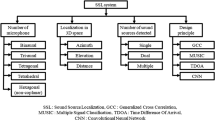Abstract
Cognitive radio combined with multiple-input multiple-output (MIMO) communications provides high data rate, efficiency and high reliability. One of the most important challenges in MIMO communication is combating MIMO multipath channel. MIMO blind equalizers and channel estimators combat MIMO multipath channels without the use of training or pilot sequences. First, the multipath channel is converted into instantaneous mixture channel (IMC), using second-order statistics of the data. Then using higher-order statistics, these mixtures are separated. However, proper selection of IMC is a major challenge. In this paper, a novel blind algorithm for choosing the best IMC is proposed. The proposed algorithm is based on the cumulant value of the received signal.





Similar content being viewed by others
References
K. Abed-Meriam, E. Moulines, P. loubaton, Prediction error method for second order blind identification. IEEE Trans. Signal Process. 45, 694–705 (1997)
C.Y. Chi, C.C. Feng, C.H. Chen, C.Y. Chen, Blind Equalization and System Identification (Springer, New York, 2006)
O.A. Dobre, A. Abdi, Y. Bar-Ness, W. Su, Survey of automatic modulation classification techniques: classical approaches and new trends. IET Commun. 1(2), 137–156 (2007)
A. Gorokhov, P. Loubaton, E. Moulines, Second order blind equalization in multiple input multiple output FIR systems: a weighted least squares approach. in Proceedings of the ICASSP, (1996), pp. 2415–2419
A. Hyvarinen, J. Karhunen, E. Oja, Independent Component Analysis (Wiley, New York, 2001)
Y. Inouye, R. Liu, A system-theoretic foundation for blind equalization of an FIR MIMO channel system. IEEE Trans. Circuits Syst. I Fundam. Theory Appl. 49(4), 425–436 (2002)
Y. Li, K.J. Ray Lin, On blind equalization of MIMO channels. IEEE Int. Conf. Commun. 2, 1000–1004 (1996)
J. Mitola III, Cognitive radio: an integrated agent architecture for software defined radio, Ph.D. Dissertation, Royal Institue of Technology (KTH), Stockholm, (2000)
E. Moulines, P. Duhamel, J. Cardoso, S. Mayrargue, Subspace methods for blind identification of multichannel FIR filters. IEEE Trans. Signal Process. 43, 516–525 (1995)
M.S. Radenkovic, T. Bose, B. Ramkumar, Blind adaptive equalization of MIMO systems: new recursive algorithms and convergence analysis. IEEE Trans. Circuits Syst. Part I 57(7), 1475–1488 (2010)
L. Rota, P. Comon, S. Icart, Blind MIMO paraunitary equalizer. Proc. IEEE Int. Conf. Acoust. Speech Signal Process. (ICASSP) 4, 285 (2003)
A. Swami, B.M. Sadler, Hierarchical digital modulation classification using cumulants. IEEE Trans. Commun. 48(3), 416–429 (2000)
M. Srensen, L. De Lathauwer, S. Icart, L. Deneire, On Jacobi-type methods for blind equalization of paraunitary channels. Signal Process. 92(3), 617–624 (2012)
J.K. Tugnait, B. Huang, On a whitening approach to partial channel estimation and blind equalization of FIR/IIR multiple-input multiple-output channels. IEEE Trans. Signal Process. 48(3), 832–845 (2000)
J.K. Tugnait, Blind estimation and equalization of MIMO channels via multidelay whitening. IEEE J. Sel. Areas Commun. 19(8), 1507–1519 (2001)
L. Tong, G. Xu, T. Kailath, A new approach to blind identification and equalization of multipath channels. IEEE Trans. Inform. Theory 40, 340–349 (1994)
H.C. Wu, Y. Wu, J.C. Principe, X. Wang, Robust switching blind equalizer for wireless cognitive receivers. IEEE Trans. Wireless Commun. 7(5), 1461–1465 (2008)
Acknowledgments
We would like to thank Dr. Amrita Satapathy for helping in editing the paper.
Author information
Authors and Affiliations
Corresponding author
Rights and permissions
About this article
Cite this article
Satija, U., Ramkumar, B. Instantaneous Mixture Channel Selection for Blind Equalization Using Cumulant Features in MIMO Systems. Circuits Syst Signal Process 35, 4596–4606 (2016). https://doi.org/10.1007/s00034-016-0272-0
Received:
Revised:
Accepted:
Published:
Issue Date:
DOI: https://doi.org/10.1007/s00034-016-0272-0




